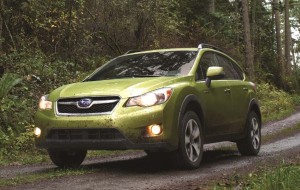After a series of false starts, Subaru finally has its first gas-electric model, the XV Crosstrek Hybrid, making its formal debut at this week’s New York International Auto Show. Expect to see more hybrids, as well as an all-electric model, possibly even a plug-in hybrid model, the Japanese maker’s top U.S. executive told TheDetroitBureau.com – but not anytime soon.
Between consumer demand and regulatory requirements, Subaru is being pressed to expand its “electrification” effort, said Tom Doll, recently promoted to president of Subaru of America. But as with the effort that finally brought the Crosstrek to market, Subaru isn’t in a rush.
“You probably won’t see more from us until around 2016 or 2017,” Doll explained, following the official roll out of the XV Crosstrek Hybrid.
Part of the issue is coming up with the resources necessary to develop new powertrain technology. But the maker also appears to be watching and waiting. There remains plenty of skepticism about just how much of a market battery-based vehicles will be able to generate.
Adding the sales of all forms from “mild” hybrids to plug-ins to pure battery-electric vehicles, or BEVs, together accounts for a little more than 3% of the U.S. market. Sales of high-profile products such as the Chevrolet Volt and Nissan Leaf continue to run well short of expectations – though Nissan CEO Carlos Ghosn on Thursday predicted this will be a “milestone year” as production of the Leaf ramps up at a new factory in Tennessee.
Subaru may be particularly well-positioned to take advantage of the growing interest in “green” vehicles, as the maker long associated with the outdoors and occasionally emphasizing its environmental policies in its advertising.
Indeed, a hybrid was something buyers clearly told Subaru researchers they wanted, and “it also will bring in more (first-time) buyers for us,” Doll predicted for the XV Crosstrek Hybrid.
What could be even more compelling is the pressure Subaru – like other major makers – will face in the coming years from increasingly stringent global regulations. That includes: tougher CO2 mandates in Europe; the 54.5 mpg Corporate Average Fuel Economy set to go into effect in the U.S. in 2025; and the Zero-Emission Vehicle (ZEV) rules adopted by California. By late in the decade, most mass makers will have to introduce BEVs or stop selling any vehicles in the Golden State.
That has led to a flood of what skeptics dub “compliance cars,” such as the Honda Fit EV and Toyota RAV4-EV. The latter maker has a growing relationship with little Subaru and reportedly assisted the smaller maker in developing the battery technology for the XV Crosstrek Hybrid.
Unfortunately for Subaru, noted Doll, Subaru relies on the distinctive “boxer” engine for most of its gas models and can’t substitute more conventional internal combustion engines used in Toyota hybrids, so it can’t simply borrow its ally’s technology.
It does plan to work with suppliers – of which there are many in the emerging field – but don’t expect to see things move much faster, at least for a few more years, stressed Doll.

